Managing resources effectively within a project is a challenge for many project managers.
Too little visibility, limited resources, or poor communication. These can all hinder effective resource management.
But the right strategies and tools can get you out of this tricky pit.
In this article, you’ll learn how to manage project resources correctly. You’ll learn about:
- Top resource management techniques
- 6 best practices for creating a resource management plan
- How to use tools and software in project resource management
What is project resource management?
Project resource management is the process of planning, allocating, and monitoring resources like people, budget, equipment, and materials.
Thus it ensures a project team has everything it needs to complete the project on schedule and within budget.
Benefits of project resource management for agencies
Project resource management is critical to delivering a project on time.
Why?
Managing resources correctly ensures that projects are never starved of resources and are delivered on time.
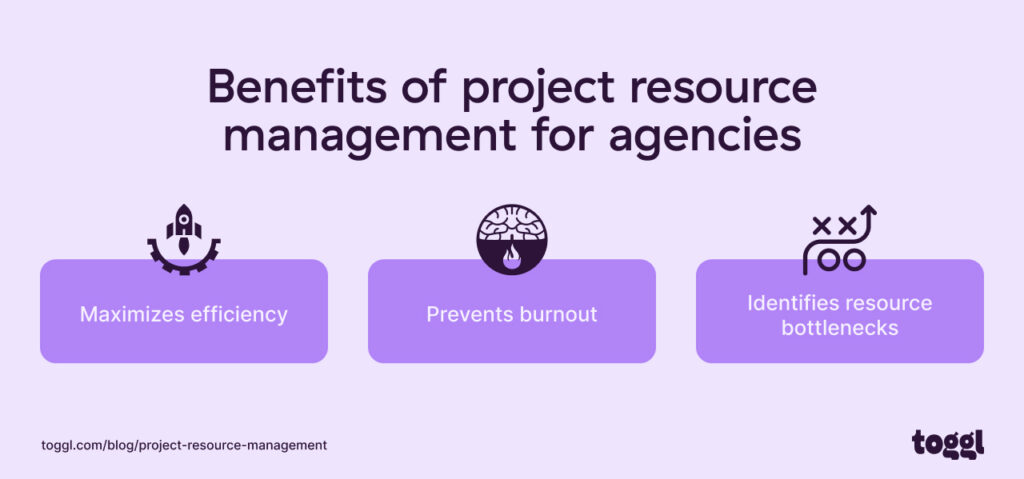
Here are three reasons why resource management is so important:
1. Increases the chances of project success
Teams can deliver projects on time when they have everything they need.
Allocating the required resources ensures that a manager can estimate the project timeline and budget more accurately.
In addition, by assigning resources at the planning stage, a manager can ensure predictable quality.
All these factors combine to help deliver a project successfully.
2. Prevents burnout
Without sufficient manpower, you’ll often see overworked team members.
Overworking leads burn out. If you don’t tackle this challenge upfront, your team may have retention challenges.
Hiring new people is always more expensive. According to a Society for Human Resource Management study, finding and training a replacement costs six to nine months of an employee’s salary.
A clear resource plan ensures you can efficiently distribute work across your entire team.
3. Identifies resource bottlenecks
In small businesses, people resources are often shared across projects.
Poor visibility into a team member’s schedule leads to scheduling conflicts and project delays.
In enterprise companies, a resource coordinator coordinates resource allocation across projects. They too need a clear overview of who’s doing what, and when.
The relationship between resource and project management
Project management steers a project from beginning to end. Resource management ensures you have all the necessary resources and use them effectively to meet the project’s objectives.
Poor project resource allocation leads to:
- Tight deadlines and heavy workloads
- Overworked team members who put in long hours
- Poor quality output as team members are under stress to deliver
Thus, effective project management requires effective resource management.
To plan a project, project managers must know what resources are available and when.
For example, if a project manager doesn’t know when a key team member is available, they can’t effectively plan tasks for that team member.
Resource managers also need to be aware of project priorities, timeline, and objectives to allocate resources effectively.
Project resource manager vs project manager
Both project resource managers and project managers play crucial roles in project planning and development. But they have different focuses.
| Project manager | Project resource manager | |
|---|---|---|
| Project manager | Project resource manager | |
| Primary focus | Overall project success, including scope, schedule, budget, and quality. | Allocation, tracking, and optimization of resources across multiple projects. |
| Key responsibilities | Define project scope and objectives. Develop a detailed project plan. Manage project risks and issues. Coordinate with stakeholders. Ensure the project stays on track in terms of time and budget. Lead and motivate the project team. Report on project progress. | Understand resource capabilities and availability. Assign resources to projects based on priorities and skill requirements. Monitor resource utilization and performance. Resolve resource conflicts and over-allocations. |
| Key skills | Leadership Risk management Time management Communication Problem-solving | Works with project managers and team lead to allocate resources appropriately. |
| Interaction with team | Directly manages and leads the project team, ensuring they have the resources and guidance needed to complete their tasks. | Works with project managers and team leads to allocate resources appropriately. |
| End goal | Successful project completion within scope, time, quality, and budget. | Efficient and effective use of resources across projects to meet organizational goals. |
Types of resources
You need various resources to achieve your project goals. These resources serve as the foundation of any task you undertake.
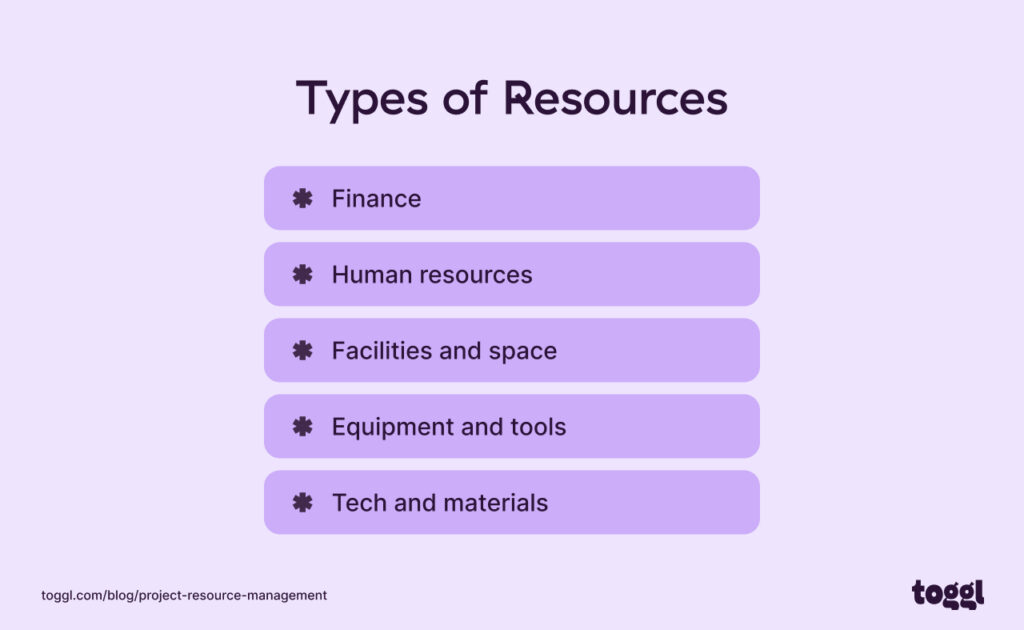
Here’s a breakdown of the different resource categories:
Finance
Finance relates to the money you set aside for a project.
This includes project budgets, investments, and other funds that keep your project running smoothly. Manage these project costs well to optimize all other resources.
Human resources
Human resources are the people on your project team including external consultants.
Their skill sets and expertise move the project forward. Make sure you assign the right roles to the right people.
Facilities and space
Every project requires a physical space, be it an office, a construction site, or a workshop. Choose a space where your team can work efficiently and safely.
Equipment and tools
The right tools and equipment can define your project’s success.
These may mean machinery for construction or software for IT tasks.
Tech and materials
Tech resources might include software or digital platforms, while materials can be different, including construction supplies or textiles.
What’s the project resource management process?
Here are five essential steps for a simple project resource management workflow:
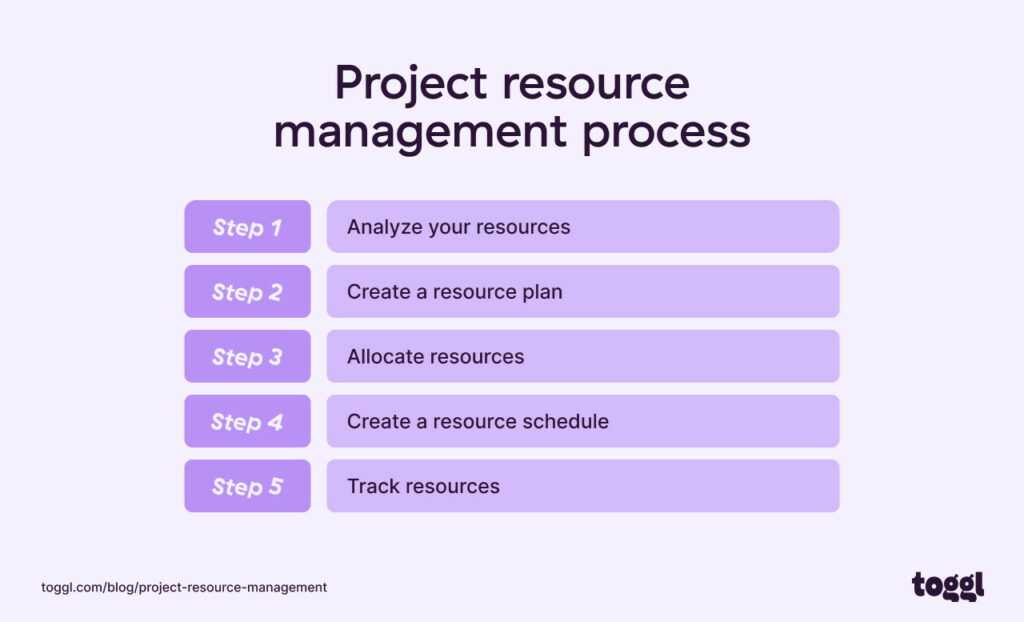
Let’s look closely at each step.
Step #1: Analyze your resources
Begin by taking stock of what you have.
List out all available resources, be it people, technology, money, or materials. Then, understand the skills, expertise, and capabilities of your team members.
This initial analysis sets the groundwork for future resource planning and allocation.
With Toggl Plan, you can set up and oversee unlimited Team timelines. You create teams by project, competencies, or department.
A Team timeline shows a team member’s schedule across projects and planned time off. The availability overview panel gives you an overview of a team member’s capacity and workload.
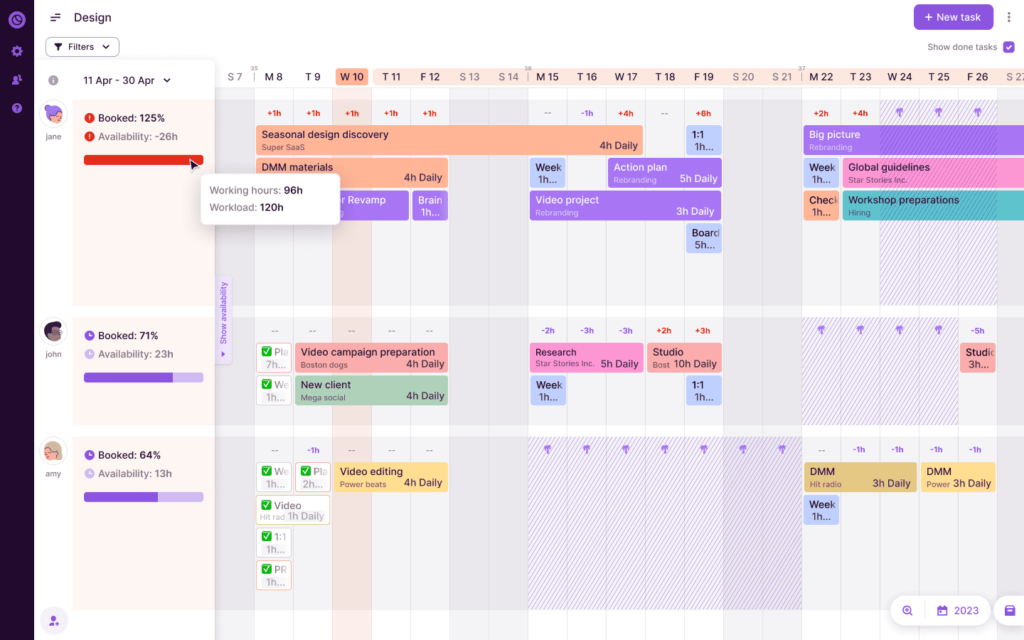
The Team timeline and the Availability Overview together gives you a clear overview of who can take on more work.
Step #2: Create a resource plan
Next, you can start drafting your resource plan.
A resource plan outlines what resources you’ll need at different stages of the project.
To create a resource plan:
- Define resource requirements based on the project scope.
- Identify resources and their availability with reference to the project’s timeline.
- Assign resources to tasks on the project timeline.
- Identify resource risks and bottlenecks.
Using a resource planning tool like Toggl Plan is a fast and efficient way to create a resource plan.
Step #3: Allocate resources
Based on the project plan, look at the existing resources and team members to identify who’s available and can take on work.
Allocate these people and resources to the project.
You may also need to initiate hiring or outsourcing if a necessary resource is unavailable.
With Toggl Plan, it is super easy to assign tasks to team members. You can even assign a task to multiple team members…

Step #4: Create a resource schedule
Based on your resource plan, you may need to adjust the project schedule to match resource availability.
A resource schedule is published once team members or other resources are booked for a project. This schedule shows the dates on which a resource is unavailable for other projects.
This helps project teams:
- Prevent scheduling conflicts with other projects
- Plan vacations and time off better
- Manage team member workloads better
Toggl Plan’s Team timelines and Availability overviews are automatically updated if a project’s schedule changes. This ensures that your resource schedule is always up to date.
Step #5: Track resources
Your last step is to monitor resource utilization and workloads.
Resource utilization measures how efficiently a project’s resources are used. Resource workload refers to the amount of work or tasks assigned to a particular resource over a specific period of time.
These metrics tell you if your team members and other resources are over or under-utilized.
Together you can use these metrics to spot potential resource risks. This insight gives you enough time to adjust your project and resource plans even in case of emergency changes.
Resource management techniques
Here are three essential project resource management techniques that you should know about.
Resource allocation
Resource allocation is the process of finding the best available resources and assigning them to projects.
With resource allocation, managers look at the available skills and capacity to book project resources.
However, most project managers don’t have a clear overview of their project resources. According to PMI, this results in wastage of up to 12 percent of project resources.
With a resource capacity planning tool like Toggl Plan, you get a bird’s-eye view of your team’s work allocation plans.
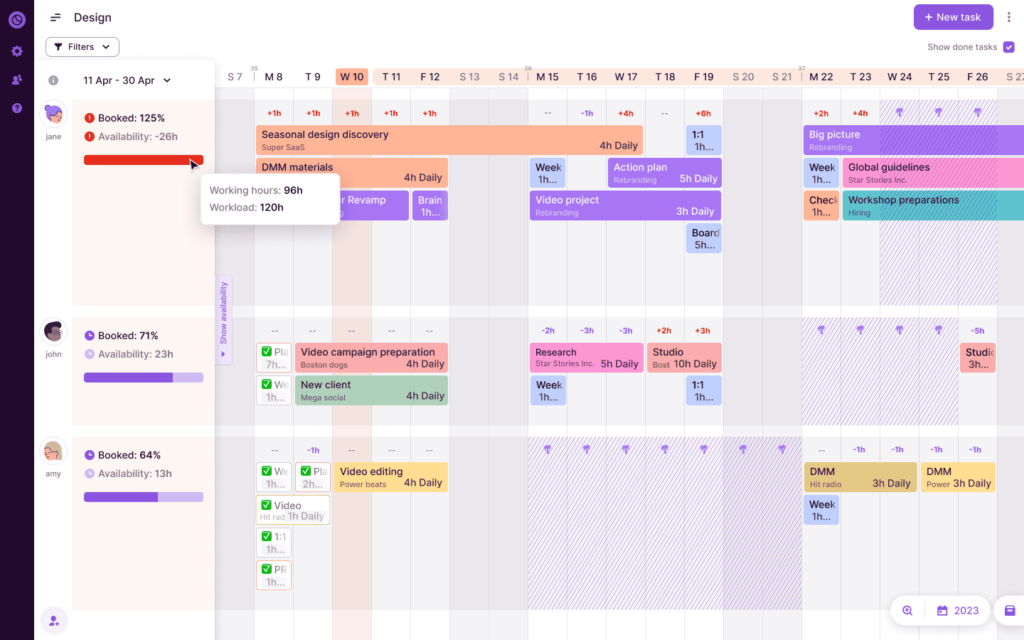
Toggl Plan’s Team timelines make it easy to visualize your team’s work schedule. Learn more about resource planning in Toggl Plan.
Visibility into your team’s long-term capacity helps you:
- Identify team members who can take up more work so you can allocate them to projects
- Identify resource bottlenecks and manage project risks
- Make hiring or outsourcing decisions to make up for the skills and capacity that your team lacks
Workload management
Once you’ve allocated team resources to a project, the next step is workload management.
What is workload management?
**Quotation** “Workload management is the process of distributing work efficiently across your team members.”
This process ensures that no one in your team is over or underworked.
In a study, Indeed.com found that more than half of the respondents felt burned out and struggled to find work-life balance.
The Availability Overview in Toggl Plan provides a quick glimpse of available resources. With this data, you can distribute tasks more effectively.
Toggl Plan also helps you manage workloads through:
- The Team Timeline: See your team’s daily tasks with the Team Timeline. You can easily spot who’s free and who’s busy for the day.
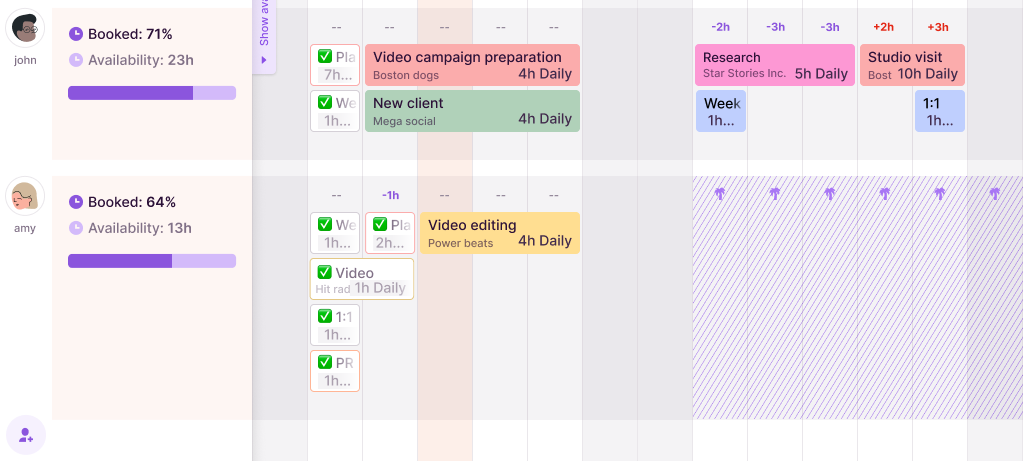
- Drag & drop functionality: If tasks change or need shifting, use the drag and drop feature. Move Gantt chart timelines easily to balance your team’s work and avoid overallocation.
- The Progress Overview feature: Compare estimated vs. actual effort to see how your project is doing. This helps you monitor project progress and change what doesn’t work before it becomes an issue.
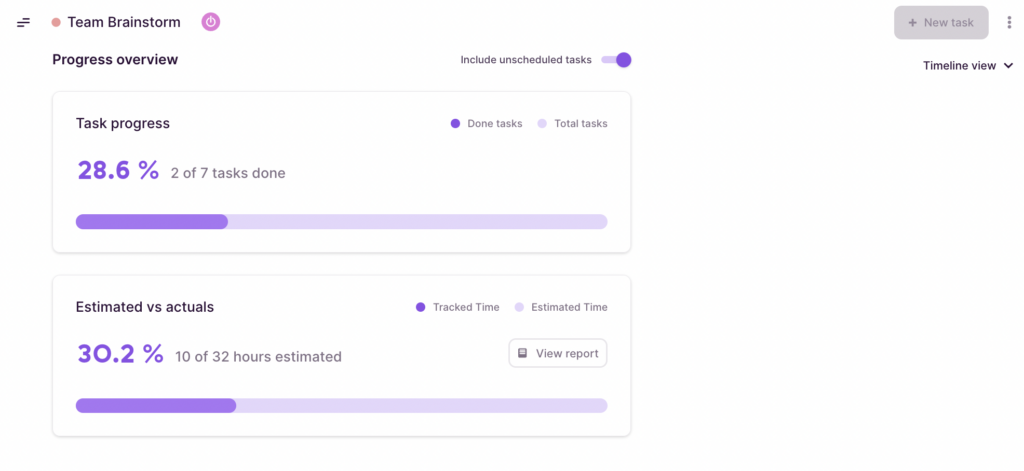
You can also use Toggl Track to manage workloads better:
- Real-time workload tracking: With Toggl Track, you see how long tasks really take. No more guessing. If something takes extra time, you’re the first to know.
- Improve future projects: Use time data from old projects to plan new ones. This way, you get a clearer idea of how long things take and can plan smarter.

The two techniques you can use to manage your team’s allocation and workloads are:
- Resource leveling: The process of planning your work schedule according to the available resources is called resource-leveling. It gives you a clear overview of what you can achieve with the available resources.
- Resource smoothing: The process of planning your work schedule within the required time while avoiding peaks and troughs in demand is called resource smoothing. Generally, delaying non-essential tasks is the preferred way to smoothen out your resource workloads.
Resource forecasting
It’s critical to allocate resources and keep an eye on your workloads.
But it’s equally important to predict resource requirements for the future.
What is resource forecasting?
“Resource forecasting is the process of anticipating your organization’s resource needs over a future period.”
Forecasting helps teams:
- Identify resource gaps and bottlenecks and take early action to mitigate these risks.
- Manage stakeholder and customer expectations by pointing out the identified people gaps.
- Demand resources early during a project’s life cycle so that HR has sufficient time to hire new people.
But resource forecasting is easier said than done.
Many project managers struggle to get it right. This might happen due to:
- Lack of past data: They might not have info from old projects. Without it, forecasting what’s needed is difficult.
- Project scope shifts: Projects can change as they go. If they do, the resources they thought they needed can change too.
- Poor communication: If their team doesn’t communicate well, they might miss or mix up resource needs. This makes forecasting tough.
What can make resource forecasting easier is Toggl Plan’s Zoom Level feature.
Toggl Plan’s Zoom Level lets you zoom in for daily details or zoom out for a weekly, monthly, or annual view.
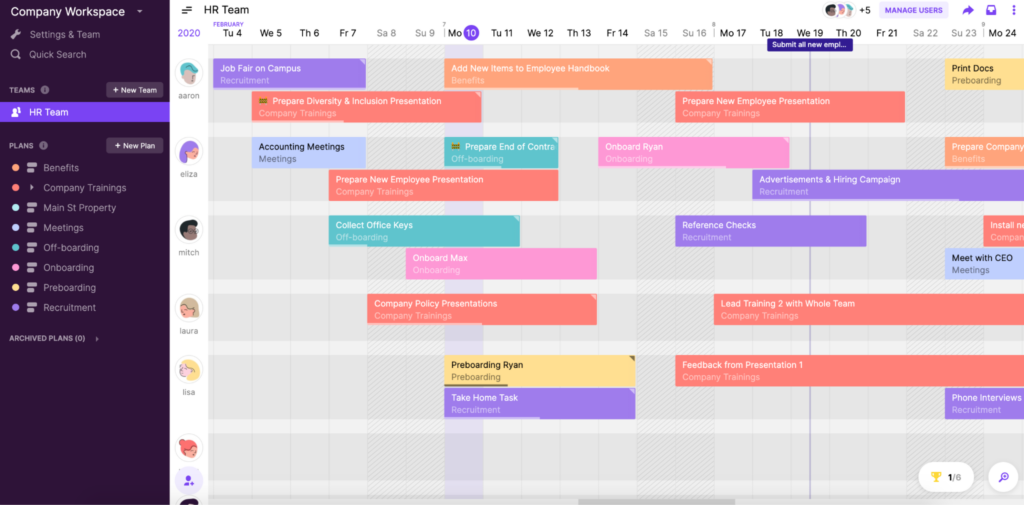
Adjust the zoom to see tasks up close or the entire project team simultaneously. This helps easily see the long term availability of of your resources.
6 project resource management best practices
Now let’s look at six project resource management best practices that help your project run smoothly.
Know your team’s capabilities
Always be aware of what each member can do.
It’s not just about roles. It’s also about strengths, skills, and experience. When you know what your team excels at, you can assign project tasks that fit them best.
Avoid resource overloading
Don’t pile too much on anyone’s plate.
If a team member is stretched too thin, they can get burned out and make mistakes. Instead, distribute tasks fairly and keep workloads manageable.
A tool like Toggl Plan helps you see who’s available and when. Its Team Timeline feature shows the exact daily capacity for each member.
Distribute tasks using this information to ensure proper resource utilization.
Keep communication sharp
Clear communication is the backbone of any project.
Always ensure everyone is on the same page and aware of their responsibilities.
Use tools or platforms that encourage regular conversations and updates.
This way, there’s no confusion, and everyone stays informed. A well-informed team makes fewer mistakes and meets more deadlines.
Track actual time spent on tasks
When you know how long tasks take, you can plan better and set realistic deadlines.
That’s why it is important to track time spent on tasks. With a tool like Toggl Track, that is super simple.
With just a few clicks, you can track all project work and get valuable metrics into how you spend your work hours.
With this level of visibility, you can refine your planning and ensure projects stay on course.
Understand true capacity
To easily estimate true capacity, consider the time allocated to non-project, admin tasks such as meetings, training, and reporting.
Gain a complete overview of your team’s time helps you gauge real work capacity.
Plan with time off in mind
When assigning tasks, factor in vacations, holidays, and personal days.
Toggl Plan has a handy Time Off feature. This feature lets you mark days when someone’s off to make sure no tasks overlap with breaks.
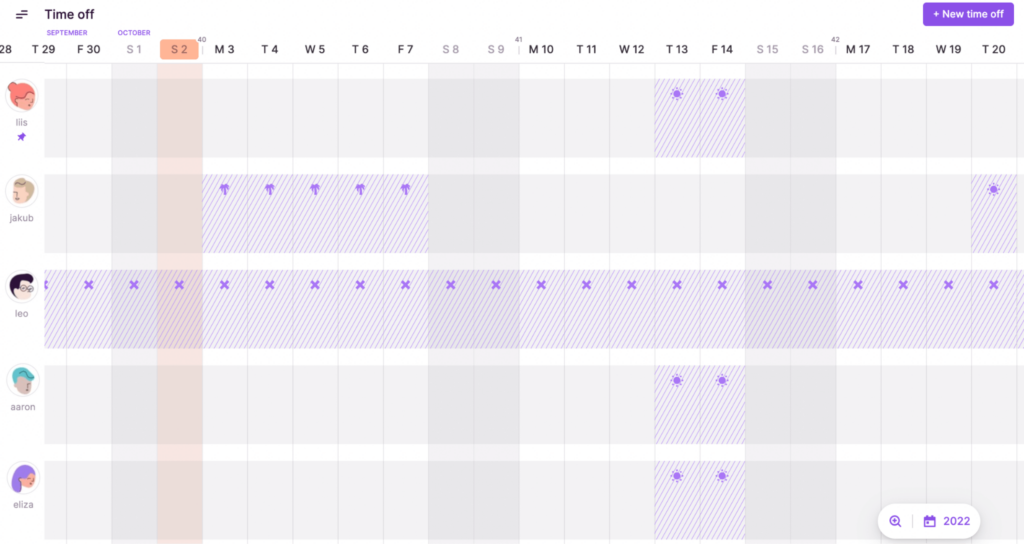
This helps to easily avoid scheduling conflicts and keep projects on track even when team members are away.
Project resource management tools and software
Project resource management tools help allocate resources more efficiently, minimize overloads, and predict potential roadblocks.
Here are some common tools for boosting resource management.
- Timeline tools: These are your project’s visual maps.
At a glance, you can see when tasks start and end, and who’s responsible. Timeline tools help you spot delays before they become big problems.
- Project resource planning tools: Resource planning tools show who’s available and when.
With them, you balance workloads better and make sure no one’s swamped or has too little work.
- Project resource management tools: Project resource management software combines features of both timeline and resource planning tools.
With them, you get a complete view of your project, from project timelines to resource availability.
You can plan, track, and adjust as your project progresses.
Free project resource management templates
A project resource management template simplifies your resource management process.
It gives you a ready-made framework to organize and monitor project resources.
With a project resource management template, you save time and effort when planning your resources.
Here are three commonly used resource management templates that you can use to manage projects.
Team availability tracker

This template helps you visually track your team’s off time, including vacations and public holidays. Once you know who’s available, you can easily allocate them to a project.
Resource allocation tracker

Using this template, you can allocate resources to projects. Plus, you can see the dates when they have the capacity to take up more work.
Resource workload tracker

Track the estimated work hours of all your employees using this template. Visualize workloads to identify who’s overworked and who has the capacity to take on more projects.
Start managing resources with Toggl Plan
Toggl Plan is a simple, visual, online work management tool for creative agencies, consultancies, and software teams.
Its timelines make it easy to visualize your project timelines and team schedules.

Unlike spreadsheets or complex software tools, Toggl Plan is easy to get started with. And keeping project information up-to-date takes even less work.
The result?
You and your team can focus on creating successful projects. Sign up for a free Toggl Plan account and see for yourself.
Work tools to elevate your productivity – apps for incredibly simple time tracking and effective project planning.
![10 Best Gantt Chart Software Tools for Success [2023]](images/untitled-design-4-1-1-746x390.jpg)

